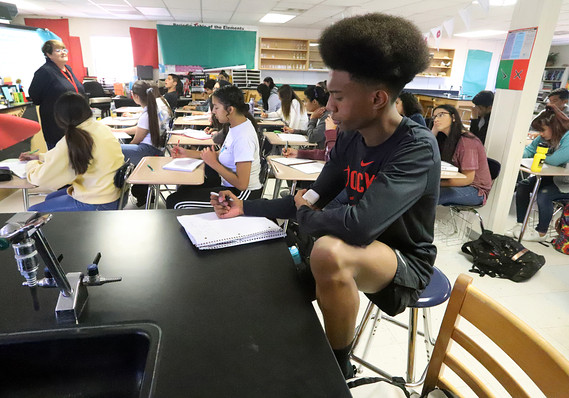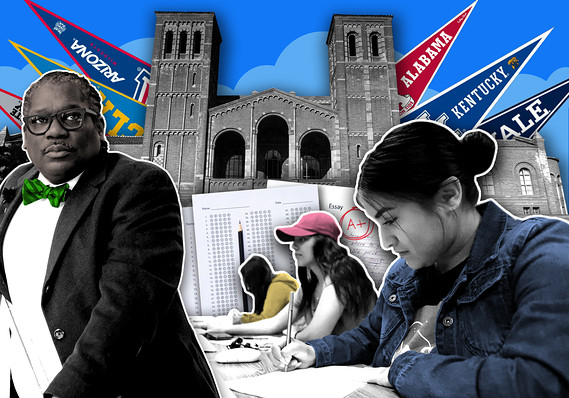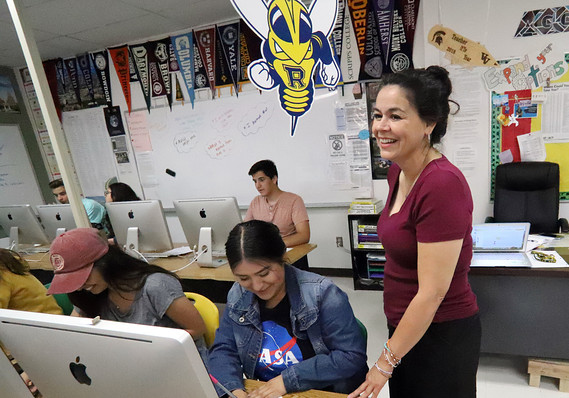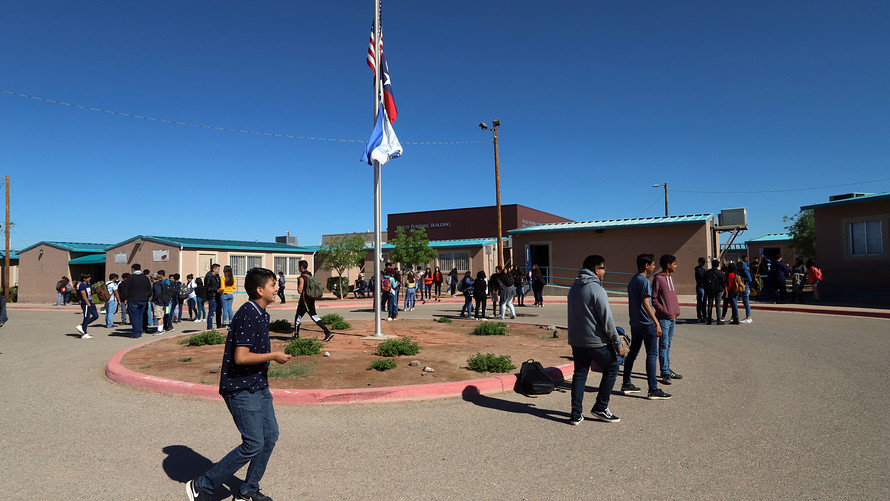 Rudy Gutierrez
Rudy Gutierrez
This is the fifth in a six-part series of stories about programs that offer high-school students the opportunity to take college classes.
The series was produced with support from the Education Writers Association Reporting Fellowship program. (Read parts one, two, three, four and six).
The soothing melodies of Norah Jones wafting through a dim lit room, musings about a future as a therapist, engineer or founder of a health-care empire — these are some of the sights and sounds one might expect to find in a coffee shop or dorm room at a small liberal-arts college.
But on a fall day last year, they served as the backdrop to a 10th grade English class at Northwest Early College High School in El Paso, Texas. Inside one of the portable classrooms set across the parking lot from the local community college that make up the school, students quietly critiqued each other’s essays on a local business personality.
One student chided his partner over a grammatical error with a “c’mon bro,” another caught her own mistake as she read her essay out loud.
Later in the week, on the other side of the Franklin Mountains, a range that lends some drama to El Paso’s desert landscape, students sat drawing self-portraits inside a portable classroom transformed by their teacher into what felt like a private club — with an entire wall made up of mirrors, black painted file cabinets and colored bulbs offering the only lighting in the room.
‘Your teachers see you as a face and a name rather than just being a number or a grade.’
In a nearby U.S. history classroom, their peers sat on couches surrounded by a homey rug or at a high-top table — “whatever helps them make their brain more comfortable,” their teacher said — discussing their works-cited page for a recent paper.
These schools feel different from the structurally rigid, football obsessed, cliquey high schools of our imagination (or in some cases, experience). And that’s by design. Northwest and Transmountain are part of El Paso’s early-college high-school movement, a collection of 12 schools where students have one foot in high school and another in community college — and where the goal is to graduate with their associate’s degree and high school diploma.
As opportunities to earn college credit have increasingly become the norm at high schools across the country, early-college high schools, which offer a sort of concentrated version of this experience, have also spread.
The aim: Put students who might not have imagined themselves in college very explicitly on a college path early in their high school career, before they have a chance to get rerouted.
Pushing students forward instead of holding them back
One of the “revolutionary” principles behind early colleges is that even students who have struggled academically might actually be more successful if they’re pushed ahead with the right support instead of asked to catch up once they’re on the cusp of college or already there, said Sarah Hooker, associate director at JFF, a nonprofit organization that’s been an advocate of early college programs.
In 2002, JFF coordinated the National Early College High School Initiative with a coalition of partner organizations interested in education and equity. Backed by the Bill and Melinda Gates Foundation, the initiative designed, launched and evaluated about 280 early college high schools, serving 800,000 students between 2002 and 2014.
As educators began experimenting with these schools, they identified Texas as a fruitful state, partly due to the relative autonomy it gives to its school districts.
As educators and nonprofits began experimenting with these schools, they identified Texas as a fruitful state for launching them, partly due to the relative autonomy the state gives to its school districts, according to Chris Coxon, the managing director of programs at Educate Texas, an initiative of Communities Foundation of Texas , an organization focused on transforming the state’s public and higher education systems.
In addition, both the size and demographics of the Texas student population meant that the state was a good place to test whether early-college high schools could be scaled across different types of regions and metropolitan areas, he said.
El Paso launched its first early college, on the Mission campus of El Paso Community College in 2006, funded in part by a grant from the Bill and Melinda Gates foundation. The region opened its second early college on the Valle Verde campus of EPCC in 2007 and then launched Northwest and Transmountain in 2008.
And officials have been expanding the program at a relatively fast clip ever since. These days, there are 12 early colleges in six of the 12 school districts that encompass El Paso with plans for several more.
 MarketWatch photo illustration
MarketWatch photo illustration
Research shows early colleges are effective, but it’s unclear exactly why
The small body of research that exists on early colleges shows them to be effective at getting their students to and through college, but we still don’t have much evidence yet on what exactly makes them effective or what makes one school more effective than another, said Julia Duncheon, an assistant professor at UTEP, who studies dual credit, dual enrollment, and early colleges.
If communities are going to scale these programs, they should be scaling what works and a too-rapid pace of expansion makes that less likely, she said.
“The way that the early-college model is playing out is a reflection of the broader national emphasis” on signals of college completion, like the number of degrees and credits earned, Duncheon said. “My question is what about quality, what about substance?”
Early colleges like Transmountain and Northwest are designed to give students a slice of the college experience, but the guard rails of high school.
Traditional early colleges like Transmountain and Northwest are designed to give students a slice of the college experience but with many of the guard rails of high school. For example, it’s students’ responsibility to walk over to the community college and show up for any of the college classes in their schedule and participate like any other student, but high school and EPCC officials collaborate to enroll students in their college courses.
They’ll also take other steps to set students up for success in their college courses. At Valle Verde Early College High School, students take a course every year called AVID that progresses each year. At the beginning of their high-school tenure, students learn skills they may need in their community college courses, like reading a syllabus and navigating office hours.
“Instead of saying ‘can I have extra credit,’ — which is what we all want — we teach them how to ask that question,” said Lailah Leeser, Valle Verde’s counselor. “I sat through the lecture, I looked this up, I still don’t understand how can I get a better understanding? That type of thing.”
By the time the students are seniors, they’re using the class to fill out college and scholarship applications. The teacher, Angelica G. Villalobos, requires the students to apply to at least five universities in the fall semester and fill out at least two scholarship applications per month.
As students sat behind large Mac monitors working on their resumes and essays, Villalobos showed me a ledger tracking all of the scholarship money, including Pell grants — the money the government provides to low and middle-income college students — in 2018: more than $7 million.
 Rudy Gutierrez
Rudy Gutierrez
‘We have really long career goals’
The students have varying goals and motivations for attending what can often be a more academically rigorous version of high school; in addition to extra homework the college courses sometimes require throughout the year, students often spend their summers in school to make sure they’re on track to graduate with an associate’s degree.
Several mentioned a parent who was interested in saving time and money or just generally getting ahead, but many students had their own reasons for attending.
“Most of us here either want to be a doctor or an engineer,” said Kate Rosales, a sophomore at Northwest. “We have really long career goals,” so any academic head start they can get is valuable, she added.
‘Most of us here either want to be a doctor or an engineer. We have really long career goals.’
Some appreciate the chance to practice some of the more intangible challenges that can come up in college, like how to manage your time or concentrate effectively on a reading assignment that can stretch dozens of pages.
“It’s better to learn those now when you’re at community college then go to a big university and completely blow it,” said Deon Maxwell, a junior at Valle Verde. “We get all of the rookie mistakes out of the way.”
But in addition to facilitating students’ ambition, many of the El Paso early colleges with their outdoor hallways, portable classrooms, relatively flexible schedules and access to a community college campus provide a vibe that some prefer to a more traditional high school environment.
“Right off the bat, I want to say that this school is so small but in a way that’s a good thing,” Emily Early, a Valle Verde senior, answered excitedly when asked about her experience. “You get to know people on a whole new level and you get to know your teachers on a whole new level. Your teachers see you as a face and a name rather than just being a number or a grade.”
That closeness offers other benefits too, Maxwell says. “They treat us a lot more like adults here.”
 Rudy Gutierrez
Rudy Gutierrez
‘They’re treated like little mini-adults’
Many of the administrators and students say they appreciate this environment. “They’re treated like little mini-adults,” Tracy Speaker-Gerstheimer, the Northwest principal told MarketWatch. Sitting in her office she wore an oversized, varsity-style cardigan with her school’s logo.
Her school with its one-and-a-half hour lunches two days a week, free periods and hordes of students walking over to the community college, is a big contrast from the typical high school where often the rules are made for the exception rather than the norm, Speaker-Gerstheimer said.
“We’re going to assume you’re going to be responsible, and 99% of the time they are,” she said, adding she hopes that taste of independence will serve them well once they start college full-time.
Still, the somewhat alternative set-up can come with its challenges.
It’s not uncommon for the early colleges to experience attrition with students transferring to more traditional schools after struggling academically.
The small setting only magnifies the anxiety surrounding one of the most challenging aspects of being a high-school student, Leeser said. “You kind of go through the dating pool pretty quickly,” she said.
In addition, she said the rigor of the program means that, for some, the environment can be an academic pressure cooker. It’s not uncommon for the early colleges to experience attrition with students transferring to more traditional schools after struggling academically.
And parents are often skeptical of sending their kids to a high school that appears to simply be a collection of trailers. Some “think a real high school has to have a football program and a marching band,” said Paul Covey, the principal at Valle Verde. Those concerns are only magnified by the fact that the school doesn’t have a large enough space to hold assemblies or other events that would bring the entire school and its parents together.
He tries to assuage those concerns by telling parents, “If preparing kids for college or a job makes you a high school, then we’re probably more of a high school than anywhere else. But a lot of them are caught up in the whole ‘rah rah’ stuff, so we try to add more of that.”
A school within a school
Some of the newest early-college high schools deal with that problem in a different way — by simply launching inside a typical high school.
As Luis Alarcon — who, as the assistant principal at Parkland High School, helped to launch an early college within his school — puts it: “For a lot of our students, the ability to still have that traditional high-school experience and be on the football team, be on the marching band and be able to do that is the best of both worlds.”
But as the early college model expands and morphs, it raises questions about what that means for an early college’s ability to prepare students to enroll and persist in college. In the course of her research, Duncheon has found that students report exposure to an actual college campus to be more impactful and to feel more like college, than courses with college-level work taught in a high-school setting.
“The early-college model can do a lot of great things for certain types of kids,” Duncheon said. “The rate at which it’s being scaled raises a lot of questions about how well it will be adopted.”
(This story was originally published on May 23, 2019.)










Add Comment